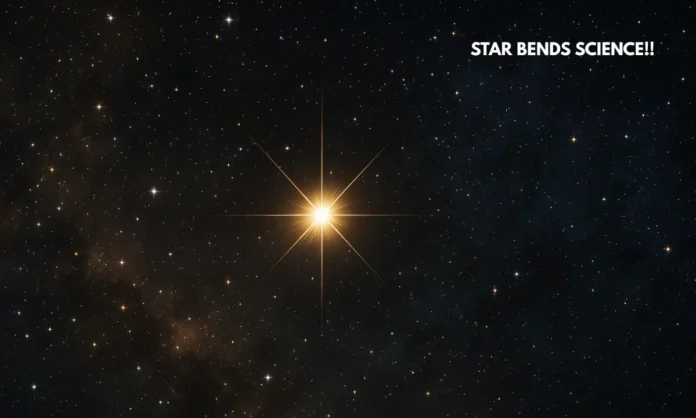Summary
- Astronomers at the Indian Institute of Astrophysics (IIA) have discovered unexpectedly high levels of germanium in A980, a rare helium-rich star 25,800 light years away.
- This marks the first-ever detection of germanium in an Extreme Helium (EHe) star, suggesting new processes at play in the aftermath of white dwarf mergers.
- The study opens up alternative theories of stellar evolution, including the possibility of A980 being a hybrid star formed through the rapid proton capture (rp) process.
A Star Like No Other: A980’s Chemical Signature Surprises Scientists
In a remote corner of the Ophiuchus constellation, 25,800 light years from Earth, a single star may be rewriting everything we thought we knew about how elements form in the cosmos. Astronomers at the Indian Institute of Astrophysics (IIA) have detected germanium—a heavy metallic element never before found in such a star—within A980, a cool Extreme Helium (EHe) star.
Initially classified as a hydrogen-deficient carbon star, A980 revealed its true identity through detailed spectroscopic analysis. Using the Hanle Echelle Spectrograph on the Himalayan Chandra Telescope in Ladakh, researchers observed a stellar fingerprint that aligned more closely with LS IV -14° 109, a known cool EHe star. What followed was even more astonishing: distinct spectral lines of singly-ionized germanium (Ge II)—marking the first-ever detection of germanium in an EHe star.
“It was unexpected,” said Dr. Gajendra Pandey, co-author of the study. “This discovery not only confirms the presence of germanium but shows it exists in levels eight times higher than in the Sun.”
Indian Institute of Astrophysics (IIA), Bengaluru scientists discover a new kind of Stellar Chemistry
— PIB India (@PIB_India) June 19, 2025
Far away in the Ophiuchus Constellation, a peculiar star named A980, 25800 light years away, is rewriting what we know about stellar chemistry
Researchers have uncovered a… pic.twitter.com/xChSsNrGVE
The Merger Theory: White Dwarfs and Cosmic Alchemy
- A980 is likely the result of a white dwarf merger—one rich in helium, the other in carbon and oxygen.
- The extreme heat and pressure from the merger likely triggered s-process nucleosynthesis, forming heavy elements like germanium.
- The star’s abundance of s-process elements (barium, strontium, etc.) supports this model.
EHe stars like A980 are among the rarest in the cosmos, likely formed when two white dwarfs collide and merge—one rich in helium, the other in carbon and oxygen. This celestial collision doesn’t just ignite new stellar life; it stirs the ingredients for cosmic chemistry on an extraordinary scale.
The detection of Ge II lines in A980 indicates that this star experienced slow neutron-capture nucleosynthesis (the s-process), a phenomenon usually associated with Asymptotic Giant Branch (AGB) stars. During this evolutionary stage, aging stars create heavy elements before shedding their outer layers.
“Not only did we detect germanium, but we also saw enhanced s-process signatures, suggesting a violent and chemically rich history,” said Ajay Saini, lead author of the study.
Is A980 More Than It Seems? The TŻO Connection
- The team has also considered a more exotic origin: Thorne–Żytkow Objects (TŻOs)—theoretical neutron star–red giant hybrids.
- TŻOs are thought to produce germanium via the rapid proton capture process (rp-process).
- While A980 doesn’t fully match a TŻO’s properties, the resemblance raises compelling questions.
What if A980 isn’t the aftermath of a white dwarf merger at all?
Researchers are also exploring the TŻO hypothesis, which involves a neutron star at the core of a red supergiant, churning out heavy elements through the rp-process. These objects are still largely theoretical, with only a handful of possible candidates ever proposed.
While A980 lacks many traits typical of a Thorne–Żytkow Object, its unusual chemical composition—especially the isolated germanium enhancement—adds weight to this rare alternative.
Dr. Pandey remains cautious but intrigued: “This discovery adds another candidate to the very short list of stars that defy classification. It challenges our understanding of how stars live and die.”
What This Means for Astronomy: A New Frontier of Elemental Origins
The detection of germanium in A980 not only represents a scientific first, but also suggests that our stellar evolution models may be missing key pathways. Until now, EHe stars were not considered likely sites for heavy-element synthesis. This find disrupts that assumption.
High-resolution spectroscopy, especially from India’s Himalayan Chandra Telescope, has proven invaluable in detecting such minute but meaningful anomalies. “This is what high-precision astronomy was built for,” said Dr. Pandey. “It shows how light alone can reveal untold cosmic stories.”
With the research published in The Astrophysical Journal, A980 is set to become a benchmark case in future studies of rare stellar classes. It may also aid in refining models around white dwarf mergers, AGB evolution, and perhaps even the elusive TŻO family.
The star A980 may be tiny in the cosmic scale, but the questions it raises are anything but. From how elements form, to what exotic fates await dying stars, this lonely helium-rich outlier has become the universe’s newest messenger.


